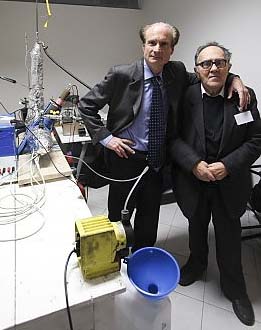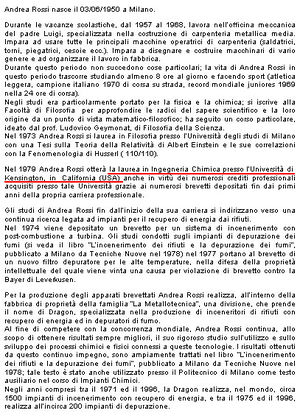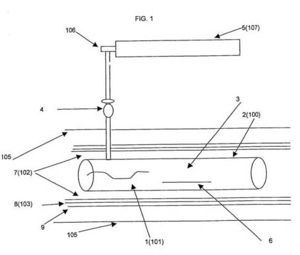Difference between revisions of "Focardi-Rossi Energy-Catalyzer"
| Line 45: | Line 45: | ||
==Undocumented experiment on 10.2.2011== | ==Undocumented experiment on 10.2.2011== | ||
| − | On February 10, 2011 a further "internal test", which was | + | On February 10, 2011 a further "internal test", which was attended by the allegedly "independent" physics instructor Guiseppe Levi from the university of Bologna, was made with the "E-Cat" in Bologna. Several websites purport that the test was instead on February 18th, 2011. According to Guiseppe Levis description, which was published in a Swedish online article with the title ''"Cold Fusion: 18 hour test excludes combustion"''<ref>Mats Lewan: ''Cold Fusion: 18 hour test excludes combustion'', "nyteknik.se", Artikel vom 23.2.2011. [http://www.nyteknik.se/nyheter/energi_miljo/energi/article3108242.ece Text]</ref>, the device was connected through a hose with a regular water tap to cool the "reactor". Tap water was said to flow through the device with about 1 liter per second and be heated by 5 degree. The test was run for 18 hours apiece, a water meter quantified the flow and was checked by video through the night. The "reactor" was allegedly heated up for 10 minutes with 1250 Watt and afterwards only the controlling device was supplied with 80 Watt. This would imply a constant thermal output of 15-20 Kilowatt. According to Levy 0,4 gramm hydrogen were used in those 18 hours. Levi is cited in the same source that he excludes "chemical energy" as heat source now: |
:''...Now that I have seen the device work for so many hours, in my view all chemical energy sources are excluded..''. | :''...Now that I have seen the device work for so many hours, in my view all chemical energy sources are excluded..''. | ||
Revision as of 18:08, 12 March 2011
Article is in translation and unfinished
The Rossi Focardi Energy Amplifier (also E-Cat or just Rossi energy amplifier) is allegedly a small fusion reactor assumed to be based on Cold Fusion. The Italian company EON srl claims to bring it to market in 2011. It is claimed to produce more than 10 kW thermal energy while needing just a couple of 100 Watts of electrical energy to power it. According to the Italian inventors, the professor emeritus in physics Sergio Focardi and the alleged engineer Andrea Rossi[1] cold fusion [2] of hydrogen and nickel to copper is happening in the reactor. As a side-effect of the reaction ionizing radiation should be emitted, but independent measurement during the experiments disproved that.[3] Attempts to replicate the experiment independently failed so far. The last public presentation was mid-January 2011.
The true inventor of the principle was the Italian biophysicist Francesco Piantelli in 1989, who filed a patent application on it in 2010.[4] Rossi, who himself tries to patent his invention, does not acknowledge that:
- "My process has nothing to do with the process of Piantelli. The proof is that I am making operating reactors, he is not."
Purported functional principle
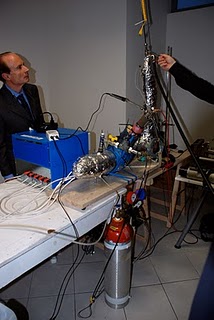
All currently known information about the "Rossi Focardi Energy Amplifier" come from the inventors, a patent application by Rossi, YouTube videos and statements from a couple of physicists which tried to replicate the principle. There is no noteworthy reception from the international physics community so far and an attempt of the inventors to publish an article about their device in a renowned professional journal failed. Only single physicists reacted with blog entries and comments (e.g.: [4]). As of March 2011 no impeccable scientific publication is known. Focardi and Rossi spread their claims through their own "online newspaper" "Journal of Nuclear Physics", basically an Internet blog and the Italian newspaper "Il Cimento". "Journal of Nuclear Physics" was the title of a Russian professional journal, which has been discontinued. The involved company EON srl has not published any information. Physicist Focardi disclosed on inquiry, that the newspaper "Journal of Nuclear Physics" was founded since the attempt to publish in an accredited journal had failed.
According to available and partly contradicting information from the inventors Focardi and Rossi the small reactor makes exothermal fusion possible. They claim that that they were able to "produce" 130 kW thermal energy in an extreme case and needed just 80 to 1250 Watt to "heat up" and for the operation of the electronic controller.
The process was unfolded only in part, even though a patent application was filed (not approved currently), involves that nickel and hydrogen are transformed to copper which creates heat and ionizing radiation. In the patent application is more precise and states that the stable nickel isotope 62Ni28 (which makes about 3,6% of normal nickel) reacts with hydrogen and is transformed into the stable copper isotope 62Cu29. The copper that is created through this process is said to consist of two stable copper isotopes with an isotope proportion that is different from natural copper.[5] Such a fusion would need very high temperatures and strong gamma radiation from the destruction of positrons and electrons would be emitted.[6]
Nickel rods are claimed to have been used at first, but in the last experiments nickel powder was used (particle sizes are said to be in the nm-range, in the patent application 10 µm are given). Rossi mentions the company "Gerli Metalli"[7] from Milan as supplier.Further catalysts in addition to those specified in the patent application are said to be used. Unconfirmed rumours in the Internet name "Raney-Nickel" since two fires in the laboratory of Rossi had "Raney-Nickel" as cause. It has been denied that nickel oxide, which reacts with hydrogen creating water and heat (NiO2 + H2 --> Ni + H20) is used.
Through heating the reactor with electricity to 180-400 Grad Celsius protons from hydrogen gas are said to enter the nickel atoms which leads to a nuclear reaction if the pressure on the gas is increased in periodical, pulsed, powerful step. Hydrogen is said to be used up and some helium is created.[8] The used nickel rod is said to have tiny craters after a reaction. According to the patent application the electrical pre-heating of the the reactor is automatically turned off by a temperature control device when operating temperature is reached. Further electrical energy (20 to 80 W) is only necessary to supply the controlling electronic. Rumours in the Internet that cannot be confirmed believe that high voltage or magnetic fields of 360 kV to overcome the Coulomb barrier might be in use. But use of such high voltage is not possible in such a small device due to spark generation.
The inventors claim that the so called "fusion" also generates weak gamma and neutron radiation.[9] Radiation is said to be β+-radiation with positrons (known from potassium 40-decay). They also claim that they don't know the functional principle. A response in their blog speculates about similarities between the Rossi Focardi Energy Amplifier and the Hydrino theorie of the american physician and electro engineer Randell Mills who claims to work with hydrogen and nickel too. Supporters of "cold fusion" theories often claim that so called Low Energy Nuclear Reactions (LENR) are happening. The term LENR is not used in professional journals and such fusion processes were not observed till now.
Other guesses from the Internet believe that it is just a chemical reaction, which is unknown to the inventors and normally used to extract nickel from ore. The Sherritt-Gordon process"[10] is accompanied by heat, but a normal chemical reaction. That copper can be detected after the reaction can be explained since Nickel is usually impure and usually contains some copper.
Application and success claims
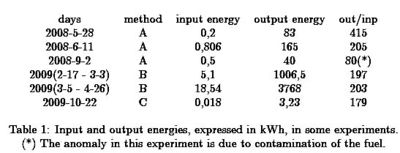
Focardi and Rossi claim that they have achieved increasing heat output of their device over the years. They state that one nickel rod is sufficient for 6 months. Rossi reports in his patent application that he heats the rooms of his company with the reactor and has saved in the last 6 months more than 90% of his electrical bill.:
- A practical embodiment of the inventive apparatus, installed on October 16, 2007, is at present perfectly operating 24 hours per day, and provides an amount of heat sufficient to heat the factory of the Company EON of via Carlo Ragazzi 18, at Bondeno (Province of Ferrara)."
A "kW-module" allegedly runs in a "Leonardo facility" in New Hampshire (USA) since 2008, where Rossi is currently employed.
History
In 1989 cold fusion received wide media attention due to the claims of Fleischmann and Pons and their failed experiments. In the same year the Italian biophysicist Francesco Piantelli(University Siena) believes to have incidentally observed strong heat emission with temperatures above 1450° C during an experiment with organic material which came into contact with nickel and hydrogen, which he could not explain. The incident was topic in several Italian daily papers. In 1995 Piantelli received a "Truffle Prize" for his observation during a "Workshop on Anomalies in Hydrogen / Deuterium Loaded Metals".[12]
The physicist Sergie Focardi from the University of Bologna heard about that and teamed up with Piantelli to investigate the phenomenon. After a couple of years they had build a nickel hydrogen rector and announced in february 1994 in a press conference their reactor as a principle for "Reazioni Nucleari a Bassa Energia" (LENR, "Low Energy Nuclear Reactions"), carefully avoiding the term "cold fusion".[13] In the daily newspaper an article was published and as before, in 1989, no scientific paper was published. A thermical engine output of 40-50 Watt was claimed. A nickel rod which was surface treated and "degassed" was said to be enclosed with hydrogen in the reactor.
Presentation on 14. January 2011
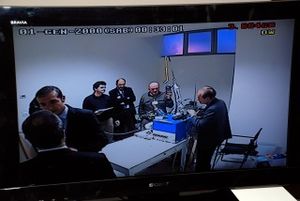
Andrea Rossi and Sergio Focardi gave a press conference on January 14th, 2011 which was not only attended by the Italian public television broadcaster RAI (RAI 3) and several journalists but also by several physicists from universities. In a nearby room the function of the reactor was shown for a couple of minutes. The inventors wrote about it in their blog[14], and published three Youtube videos in Italian [5], [6], [7].
During the pressconference they stated that the heat input was 600 Watt and the estimated output 12.000 Watt (12 kW). The produced heat was calculated from the heated water: 292 gramm water per minute were heated from 20 degree to 101 degrees(dry vapor) and evaporated. The attending physicists were allowed to do some measurements. They were disappointed in regard to a spectral analysis of the gamma radiation which was denied because of secrecy reasons. In a detailed report from independent physicists from the university of Bologna was stated, that no gamma radiation could be measured, even though two holes were made into the device for measurement purposes. From the report:
- no gamma radiation above the background level in the energy region Eγ > 200 keV has been observed, neither in single counting, not in coincidence;
regardless of the internal details of the reaction chamber, shieldings and other industrial secrets, the γ rates measured with the NaI counters seem not compatible with the rates deduced or expected assuming that the energy production was due to nuclear fusion or decay reactions, as suggested in [1].
The observers were allowed to weigh the hydrogen gas container before and after the experiment (Weight: 18,6 Kg). Even considering possible errors in measurement (still attached duct tapes) the hydrogen usage was estimated at less than one gramm, not enough to make conventional hydrogen combustion plausible. Link to the report: [8] The estimation of the reactor output through the amount of evaporated water was criticized afterwards, calculations were made based on dry vapor without taking possible condensate water into account. The alleged water throughput of 292 ml/min was doubted, since the alleged supply pump has only about half the necessary flow rate.
Undocumented experiment on 10.2.2011
On February 10, 2011 a further "internal test", which was attended by the allegedly "independent" physics instructor Guiseppe Levi from the university of Bologna, was made with the "E-Cat" in Bologna. Several websites purport that the test was instead on February 18th, 2011. According to Guiseppe Levis description, which was published in a Swedish online article with the title "Cold Fusion: 18 hour test excludes combustion"[15], the device was connected through a hose with a regular water tap to cool the "reactor". Tap water was said to flow through the device with about 1 liter per second and be heated by 5 degree. The test was run for 18 hours apiece, a water meter quantified the flow and was checked by video through the night. The "reactor" was allegedly heated up for 10 minutes with 1250 Watt and afterwards only the controlling device was supplied with 80 Watt. This would imply a constant thermal output of 15-20 Kilowatt. According to Levy 0,4 gramm hydrogen were used in those 18 hours. Levi is cited in the same source that he excludes "chemical energy" as heat source now:
- ...Now that I have seen the device work for so many hours, in my view all chemical energy sources are excluded...
A claimed accumulated thermal energy output was calculated by supporters of "Cold Fusion" (LENR Low Energy Nuclear Reactions - CANR Chemically Assisted Nuclear Reactions) as 270-288 kWh (about one GJ), which would correspond to about 26 liters heating oil.[16] Assuming an average output of 17 kW (the electrical input energy for pre-heating and control can be neglected) over 18 hours gives actually about 300 kWh. The fuel value of 1 liter oil is about 10 kWh[17], which gives a heating oil amount of 30 liters to produce the same thermal output.
For comparison, the heating value of common energy sources. Because of smoke, exhaust fumes and toxicity(beryllium) they are not feasible. The volume of the external control unit is said to be about 60 liter but contains according to Rossi only electronic. The reaction chamber has about 1 liter volume and the shielding which is said to be 2 cm lead with a weight of 30 kg.
- Beryllium – Verbrennung mit Sauerstoff: 125 MJ/l (very toxic)
- Bor: 138 MJ/l
- Aluminum 84 MJ/l (burns only in powder form, which implies has lesser heating value per volume)
- Graphit: 73 MJ/ll
Attempts to replicate the experiments
Inventor Andrea Rossi
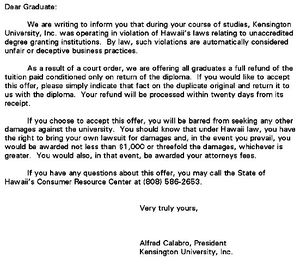
EON srl, Leonardo Corporation and Defkalion Green Technologies
Patents and patent applications
Literature
- Giuseppe Levi: "Report on heat production during preliminary tests on the Rossi “Ni-H” reactor", Univ. Bologna, Jan. 2011 (auch: [9])
- "Italian scientists claim to have demonstrated cold fusion", Physorg, 20.1.2011
- "Il ritorno della fusione fredda", Artikel in der Zeitschrift "Query", 31.1.2011
- "Il ritorno della fusione fredda: ci risponde Levi", Artikel in der Zeitschrift "Query", 2.2.2011
- Focardi S., Habel R., and Piantelli F., "Anomalous Heat Production in Ni-H Systems," Nuovo Cimento, Vol. 107A, p. 163-167, (1994)
- Notoya, R. et al., "Tritium Generation and Large Excess Heat Evolution by Electrolysis in Light and Heavy Water-Potassium Carbonate Solutions With Nickel Electrodes," Fusion Technology, Vol. 26, p. 179, (Sept. 1994)
- Cerron-Zeballos, E., Crotty, I., Hatzifotiadou, D., Lamas Valverde, J., Williams, M.C.S., and Zibichi, A., "Investigation of Anomalous Heat Production in Ni-H Systems," Nuovo Cimento, Vol. 109A, p. 1645-1654, (1996)
- Mengoli, G., Bernardini, M., Manducchi, C., and Zannoni, G., "Anomalous Heat Effects Correlated With Electrochemical Hydriding of Nickel," Il Nuovo Cimento, Vol. 20 D, p. 331-352, (1998)
- Battaglia, A., Daddi, L., Focardi, S., Gabbani, V., Montalbano, V., Piantelli, F., Sona, P.G., and nesi, S., "Neutron Emission in Ni-H Systems," Nuovo Cimento, Vol. 112 A p. 921-931, (Sept. 1999)
- S. Focardi, V. Gabbani, V. Montalbano, F. Piantelli, S. Veronesi. "Large excess heat production in Ni-H systems". Il Nuovo Cimento Vol. 111 A, N.11 pp. 1233, novembre 1998
- Cerron-Zeballos, E., Crotty, I., Hatzifotiadou, D., Lamas Valverde, J., Williams, M.C.S., and Zichichi, A., "Investigation of Anomalous Heat Production in Ni-H Systems". Nuovo Cimento, Vol. 109A, p. 1645-1654, (1996).
- Adalberto Piazzoli. "Fusione Fredda? Una ricerca italiana". CICAP - Scienza & Paranormale N. 78 (Mai 2008)
News
- Franco, Foresta Martin, "Siena scopre l' energia pulita Fusione fredda all' italiana?," Corriere Della Sera, 19. Februar 1994
- Ilaria Venturi: Fusione nucleare a freddo - "A Bologna ci siamo riusciti", Artikel in "La Repubblica" (Bologna-Lokalausgabe) vom 14.1.2011. [10]
Weblinks
- Internetseite von Andrea Rossi
- "Journal of Nuclear Physics". Der Titel suggeriert eine physikalische Zeitschrift, tatsächlich handelt es sich um eine von Focardi und Rossi betriebene, Blog-ähnliche Internetseite, deren Beiträge aber angeblich einen Peer Review durchlaufen und von "mindestens einem" Physikprofessor begutachtet würden.
- http://www.eonsrl.com (aktuell ohne Inhalt)
- http://pages.csam.montclair.edu/~kowalski/cf/388amplifier.html
- http://www.newenergytimes.com/v2/news/2008/NET29-8dd54geg.shtml
References
- ↑ Rossi: I am a doctor in the Philosophy of Science and Engineering from the Universita’ Degli Studi Di Milano
- ↑ Andrea Rossi in his patent application, Page 12: the reaction actually provides a true nuclear cold fusion.
- ↑ http://www.psiram.com/doc/Levi%2C_Giuseppe_-_Report_on_heat_production_during_preliminary_tests_on_the_Rossi_Ni-H_reactor_%282010-2011%29.004810.pdf
- ↑ WO 2010058288 A1: METHOD FOR PRODUCING ENERGY AND APPARATUS THEREFOR. 2010-05-27. Erfinder: PIANTELLI SILVIA; PIANTELLI FRANCESCO
- ↑ According to S. Focardi in an E-Mail: [...] mostra l'esistenza di Cu (non presente inizialmente) i cui due isotopi stabili sono in un rapporto diverso da quello naturale [...]
- ↑ According to Prof. Jonghwa Chang, Chief Research Advisor of the "Korea Atomic Energy Research Institute", answer to an inquiry by an Italian chemist. see: [1]
- ↑ Powder nickel: Gerli Metalli--Milan
- ↑ S. Focardi, V. Gabbani, V. Montalbano, F. Piantelli, S. Veronesi. "Large excess heat production in Ni-H systems". Il Nuovo Cimento Vol. 111 A, N.11 pp. 1233, novembre 1998
- ↑ Battaglia, L. Daddi, S. Focardi, V. Gabbani, V. Montalbano, F. Piantelli, P.G. Sona, S. Veronesi. "Neutron emission in Ni-H Systems". Nuovo Cimento 112A, pp. 921, 1999.
- ↑ http://en.wikipedia.org/wiki/Cobalt_extraction_techniques#Recovery_from_nickel-cobalt_sulfide_concentrates_.28Sherritt_process.29
- ↑ S. Focardi, A. Rossi: A new energy source from nuclear fusion., journal og nuclear physics. [2]
- ↑ "Truffle Prize", second Asti Workshop on Anomalies in Hydrogen / Deuterium Loaded Metals, 1995
- ↑ Press conference on 20. February 1994, Aula magna, University Siena
- ↑ http://www.journal-of-nuclear-physics.com/?p=360
- ↑ Mats Lewan: Cold Fusion: 18 hour test excludes combustion, "nyteknik.se", Artikel vom 23.2.2011. Text
- ↑ Zitat:
News Rossi 18-hour demonstration February 2011 On February 10 and 11, 2011, Levi et al. (U. Bologna) performed another test of the Rossi device. Compared to the January 14 test, they used a much higher flow rate, to keep the cooling water from vaporizing. This is partly to recover more heat, and partly because Celani and others criticized phase-change calorimetry as too complicated. There were concerns about the enthalpy of wet steam versus dry steam, and the use of a relative humidity meter to determine how dry the steam was. A source close to the test gave Jed Rothwell the following figures. These are approximations: Duration of test: 18 hours Flow rate: 3,000 L/h = ~833 ml/s. Cooling water input temperature: 15°C Cooling water output temperature: ~20°C Input power from control electronics: variable, average 80 W, closer to 20 W for 6 hours The temperature difference of 5°C * 833 ml = 4,165 calories/second = 17,493 W. Observers estimated average power as 16 kW. A 5°C temperature difference can easily be measured with confidence. 3,000 L/h is 793 gallons/h, which is the output of a medium-sized $120 ornamental pond pump. The control electronics input of ~80 W is in line with what was reported for tests before Jan. 14. Input power was high on that day because there was a problem with cracked welding, according to the Levi report. 18 hours * 16 kWh = 288 kWh = 1,037 MJ. That is the amount of energy in 26 kg of gasoline (7.9 gallons). Given the size and weight of the device, this rules out a chemical source of energy. Levi et al. are expected to write another paper about this test. We will upload it when it becomes available. NyTeknik published a fascinating description of the latest experiment (in English). This includes new details, such as the fact that the power briefly peaked at 130 kW. NyTeknik also published an interview with two outside experts about the demonstration: Prof. Emeritus at Uppsala University Sven Kullander, chairman of the National Academy of Sciences Energy Committee, and Hanno Essén, associate professor of theoretical physics, Swedish Royal Institute of Technology. Two versions are available, in English and Swedish.
LENR-CANR Org. News von Februar 2011. [3] - ↑ http://en.wikipedia.org/wiki/Heating_oil
